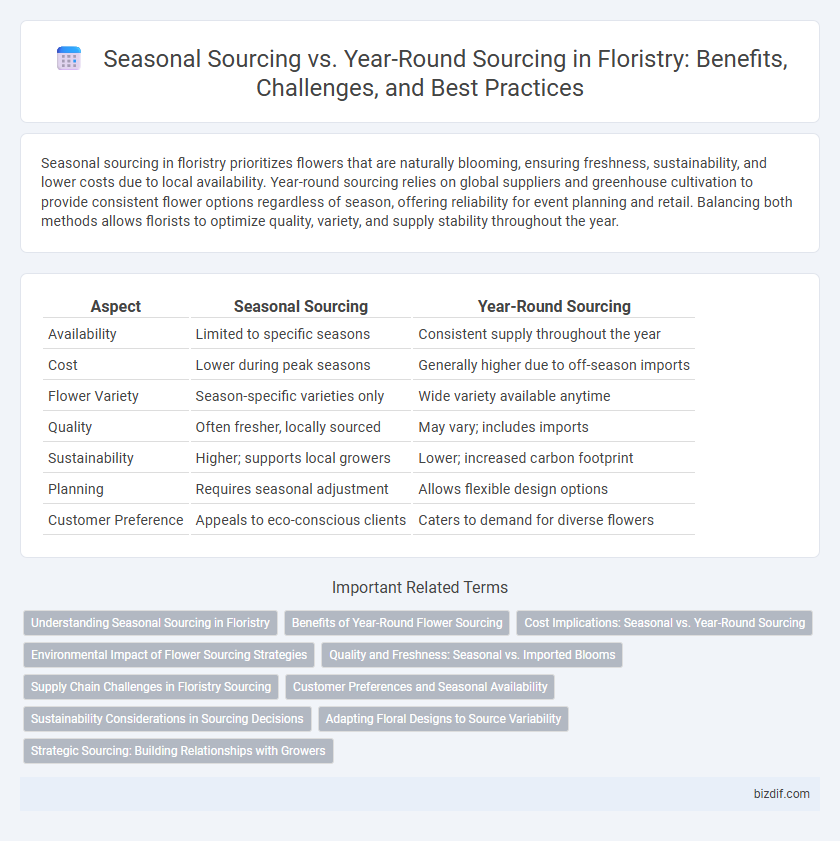Seasonal sourcing in floristry prioritizes flowers that are naturally blooming, ensuring freshness, sustainability, and lower costs due to local availability. Year-round sourcing relies on global suppliers and greenhouse cultivation to provide consistent flower options regardless of season, offering reliability for event planning and retail. Balancing both methods allows florists to optimize quality, variety, and supply stability throughout the year.
Table of Comparison
| Aspect | Seasonal Sourcing | Year-Round Sourcing |
|---|---|---|
| Availability | Limited to specific seasons | Consistent supply throughout the year |
| Cost | Lower during peak seasons | Generally higher due to off-season imports |
| Flower Variety | Season-specific varieties only | Wide variety available anytime |
| Quality | Often fresher, locally sourced | May vary; includes imports |
| Sustainability | Higher; supports local growers | Lower; increased carbon footprint |
| Planning | Requires seasonal adjustment | Allows flexible design options |
| Customer Preference | Appeals to eco-conscious clients | Caters to demand for diverse flowers |
Understanding Seasonal Sourcing in Floristry
Seasonal sourcing in floristry emphasizes using flowers that naturally bloom during specific times of the year, ensuring freshness, sustainability, and cost-effectiveness. By aligning floral designs with seasonal availability, florists can offer unique and vibrant arrangements while supporting local growers and reducing carbon footprints. Understanding seasonal sourcing enables efficient inventory management and enhances customer satisfaction through timely, high-quality blooms.
Benefits of Year-Round Flower Sourcing
Year-round flower sourcing ensures consistent availability of diverse floral varieties, allowing florists to meet client demands regardless of season. This approach supports stable pricing and supply chain reliability, reducing the risk of shortages or inflated costs during off-peak periods. Access to global flower markets through year-round sourcing enhances creative design options and improves customer satisfaction with fresh, high-quality blooms.
Cost Implications: Seasonal vs. Year-Round Sourcing
Seasonal sourcing in floristry often reduces costs by aligning flower purchases with natural bloom periods, minimizing expenses related to artificial growing environments and long-distance transportation. Year-round sourcing incurs higher costs due to greenhouse cultivation, import fees, and increased logistics complexity to maintain consistent flower availability regardless of season. Evaluating cost implications between seasonal and year-round sourcing helps florists optimize budgets while balancing flower variety and quality.
Environmental Impact of Flower Sourcing Strategies
Seasonal sourcing of flowers significantly reduces the carbon footprint by limiting the need for energy-intensive greenhouses and long-distance transportation, thereby decreasing greenhouse gas emissions. Year-round sourcing often relies on imports and artificial growing conditions, leading to higher energy consumption and increased environmental degradation. Emphasizing local, seasonal blooms supports biodiversity and reduces water usage, promoting more sustainable floristry practices.
Quality and Freshness: Seasonal vs. Imported Blooms
Seasonal sourcing ensures blooms are harvested at peak freshness, resulting in higher quality and more vibrant colors compared to imported flowers which often endure long transit times. Year-round sourcing provides availability of diverse flower varieties but may compromise freshness due to extended storage and shipping periods. Florists focusing on quality prioritize seasonal blooms for their natural vitality and fragrance, enhancing customer satisfaction.
Supply Chain Challenges in Floristry Sourcing
Seasonal sourcing in floristry introduces supply chain challenges such as fluctuating availability and increased transportation costs due to regional harvesting periods, impacting freshness and lead times. Year-round sourcing demands robust supplier networks and advanced inventory management to mitigate risks linked to unpredictable weather and market dynamics. Efficient coordination between growers, distributors, and retailers is crucial to balance cost, quality, and delivery reliability in both sourcing strategies.
Customer Preferences and Seasonal Availability
Seasonal sourcing in floristry offers customers fresher, more vibrant blooms reflective of natural growth cycles, enhancing the overall aesthetic appeal and sustainability of arrangements. Year-round sourcing provides consistent availability of popular flowers, catering to customer demand for specific varieties regardless of season but may involve higher costs and environmental impact. Understanding customer preferences for freshness and variety helps florists balance seasonal availability with reliable supply to optimize satisfaction and inventory management.
Sustainability Considerations in Sourcing Decisions
Seasonal sourcing in floristry reduces carbon footprints by minimizing long-distance transportation and supports local ecosystems through timely harvesting. Year-round sourcing often relies on imports, increasing energy consumption and greenhouse gas emissions due to extended cold storage and freight. Prioritizing seasonal blooms aligns with sustainable practices by enhancing biodiversity and reducing waste in floral supply chains.
Adapting Floral Designs to Source Variability
Adapting floral designs to source variability requires balancing seasonal sourcing with year-round availability to maintain freshness and visual appeal. Seasonal sourcing offers unique, often locally-grown blooms that enhance sustainability and support regional growers while inspiring designs aligned with natural cycles. Year-round sourcing ensures consistent inventory and availability of popular flowers, enabling florists to meet client demands and create reliable arrangements despite seasonal fluctuations.
Strategic Sourcing: Building Relationships with Growers
Strategic sourcing in floristry involves cultivating long-term relationships with growers to ensure consistent quality and availability of flowers. Seasonal sourcing allows florists to offer fresh, locally-grown blooms aligned with natural growing cycles, enhancing product authenticity and supporting sustainable practices. Year-round sourcing requires partnerships with diverse growers across different regions, enabling a steady supply of popular varieties regardless of season, thereby meeting consumer demand and maintaining competitive advantage.
Seasonal sourcing vs Year-round sourcing Infographic

 bizdif.com
bizdif.com